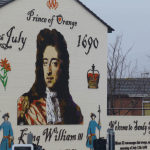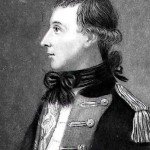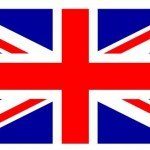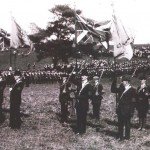
Northern Ireland is a country of the United Kingdom. To understand its history, one must know a little of the troubled relationship between England and Ireland. In July 1690 a Protestant force of 36,000 men, led by William of Orange, defeated a smaller Catholic force at the Battle of the Boyne, near the city of Drogheda. Twelve months later Protestant forces again triumphed over Jacobites [supporters of the Catholic King James II] at Aughrim in County Galway. These victories spelt the end of Jacobite resistance and the beginning of the so-called Protestant Ascendancy. Catholic aristocrats in Ireland were stripped of their estates; by the mid-1700s more than nine-tenths of all land in Ireland was owned and controlled by Protestants. The passing of the Penal Laws in the late 17th and 18th centuries discriminated against Catholics in religion, education and politics. Catholics and other non-Protestant religions were excluded from voting and political participation. By the middle of the 1700s, Britain had established control over Ireland and Anglo-Irish landowners filled the benches of the Irish parliament. Since Britain was a significant imperial power, with the world’s largest military and naval force, Irish Catholics could do little to resist her supremacy.
The last quarter of the 1700s saw a transformation in Irish society and politics. Some of this stemmed from political changes outside Ireland and a softening of English attitudes towards Catholicism. In the 1770s Anglo-Irish politicians, inspired by ideas of liberty and equality, began to soften and wind back the Penal Laws. Irish Catholics were allowed some property rights and a measure of political participation. By the 1790s Catholics could buy and own land, study at Trinity College in Dublin, practice as lawyers and vote in elections (if they owned property). The 1790s also saw the formation of an indigenous nationalist movement in Ireland. This was encouraged by global events such as the American and French Revolutions, which sent ideas of liberty, equality and self-government echoing around the globe. Inspired by these examples many Irishmen sought to form their own independence movements, to throw off repressive English rule and establish their own self-government.
Wolfe Tone and the 1798 Rebellion

These Irish nationalists launched several uprisings in the late 18th and early 19th centuries. The most significant was a 1798 rebellion, aimed to free Ireland from British rule. The leader of this uprising, Wolfe Tone, was a founding member of the Society of United Irishmen, one of the first significant nationalist groups. Tone had been in communication with French revolutionaries, something that aggravated London, which declared war on France in 1793. Fearful the French revolutionary government might use Ireland to stage an invasion or attack on Britain, London banned the Society of United Irishmen (May 1794). But the Society continued illegally and later encouraged a French naval landing on Irish soil. Their suspicions of a French-Irish Nationalist alliance confirmed, the British brutally suppressed the United Irishmen and encouraged Protestant groups like the Orange Order to harass its members. Wolfe Tone and the Society launched their anti-British rebellion in May 1798 and enjoyed some initial success. By August, however, the rebels had been crushed at Vinegar Hill and their leaders had been arrested, executed or driven into hiding. Wolfe Tone was captured in October, put on trial in Dublin and sentenced to death. He committed suicide while awaiting execution.

These defeats showed Irish radicals that armed rebellion against the British was unlikely to succeed, so they sought other paths to freedom. British rulers, in contrast, grew fearful that political instability and rising nationalism might lead to a Catholic-dominated Irish parliament. In 1800 London took action, passing the Act of Union. This legislation abolished the Irish parliament and absorbed Ireland into the United Kingdom, effectively ending Irish autonomy. The British promised Irish Catholics full emancipation and voting rights, however it took almost 30 years for this promise to be fulfilled. The Act of Union fuelled another increase in Irish nationalism and gave rise to a campaign for Catholic emancipation, led by Daniel O’Connell. Emancipation was finally legislated in 1829, allowing Irish Catholics to stand for political and public office. This opened the way for Irish Nationalists to stand for seats in the British parliament and push for Home Rule (self-government) in Ireland. These ‘Parliamentary Nationalists’ sought a political route to autonomy and independence.
Irish Nationalist groups
“From the mid-1860s to 1914 the Irish problem was frequently the prime issue in British politics. It absorbed more time and energy than any other question. There was little about Ireland which was not aired at length in the press, in parliament and at the dinner tables of the political elite. Fenianism obsessed British minds… at the end it seemed all too possible that Irish Home Rule would spark off the largest civil disruption in the British Isles since the 17th century… Failure to resolve the Irish problem by 1914 left a bitter legacy and was a major factor in giving birth to contemporary Northern Ireland violence.”
Alan O’Day, historian
The mid-1800s saw several Irish Nationalist groups organise and take shape. The Irish Republican Brotherhood (IRB) was formed in 1858. The IRB demanded the repeal of the Act of Union and the restoration of Irish self-government while raising awareness and relief for impoverished Irish Catholics. One of its more successful programs was the creation of a Land League to assist Catholic farmers in danger of eviction from unjust landowners. In the 1870s several political groups were formed to advance the case for Home Rule. One was the Irish Nationalist Party, which in 1882 became the Irish Parliamentary Party (IPP). By 1885 the IPP had 85 members sitting in the British parliament at Westminster. IPP Members of Parliament proposed the first two Home Rule bills in 1886 and 1893. Both bills were defeated but the Nationalists were now a political force worthy of notice, evidence of widespread public support for Irish independence.
The Nationalist landscape changed further in 1905 with the formation of Sinn Fein (Irish Gaelic for ‘We Ourselves’). Sinn Fein was founded by Arthur Griffith, a Dublin-born journalist and a member of the IRB. Griffith was fervently anti-British, a position hardened by his experiences of British imperialism in South Africa during the Boer War. Griffith reached the conclusion that the best path to Irish independence was revolution, not reform. He declared the Act of Union illegal and condemned participation in the British parliament as collaboration. Griffith called for Irish MPs to withdraw from Westminster and establish their own parliament in Ireland. British rule, he argued, should simply be ignored. In its first decade, Sin Fein was too small to exert much influence and to radical to attract much public support. Griffith’s party would remain a fringe group until after the 1916 Easter Rising.

The rise of the Loyalists
The situation changed again in May 1914 when the British parliament passed the third Home Rule Act, also known as the Government of Ireland Act. This legislation was the culmination of the Home Rule movement, however it did not please everyone in Ireland. The first Home Rule Bill in 1886 had also given rise to the Irish Unionist Party, a coalition of Protestant Anglo-Irish and British conservatives who opposed self-government in Ireland. Most of this anti-Home Rule sentiment was based in north-eastern Ireland, in six of the nine Ulster counties. By 1905 this movement had solidified into the Ulster Unionist Party (UUP). The UUP was determined to remain under British rule and threatened repeatedly to take up arms against Nationalists, should Home Rule be accepted. In 1912, with the passing of a Home Rule Bill likely, these Loyalists formed a private army called the Ulster Volunteers. Nationalist groups like Sinn Fein and the IRB responded by forming their own paramilitary force, called the Irish Volunteers. With these two private armies promising to defend or destroy Home Rule, it seemed Ireland might collapse into a state of civil war. This prospect was delayed, though not averted, by the August 1914 declaration of World War I.

1. England’s domination of Ireland began in the late 1600s with a Protestant victory at the Battle of the Boyne, followed by the defeat of the Jacobites at Aughrim.
2. Irish Nationalism began to emerge in the late 1700s, inspired by successful revolutions abroad and the formation of the Society of United Irishmen.
3. Following the failed Wolfe Tone rebellion in 1798, England extended its control by passing the 1800 Act of Union that dissolved the Irish parliament.
4. Ireland’s Catholics were later granted some property rights and political participation, though most remained marginalised, exploited and impoverished.
5. Irish Nationalists organised and mobilise in the mid-1800s, gaining seats in the British parliament and pushing for Home Rule. This was opposed by Protestants in the north-east, who formed Unionist political parties and paramilitaries to fight against it.

Extracts from the Penal Laws (1695-1745)
© Alpha History 2017. Content on this page may not be republished or distributed without our express permission. For more information please refer to our Terms of Use.
This page was written by Rebekah Poole and Jennifer Llewellyn. To reference this page, use the following citation:
R. Poole and J. Llewellyn, “Anglo-Irish relations 1690-1914”, Alpha History, accessed [today’s date], https://alphahistory.com/northernireland/anglo-irish-relations-1690-1914/
